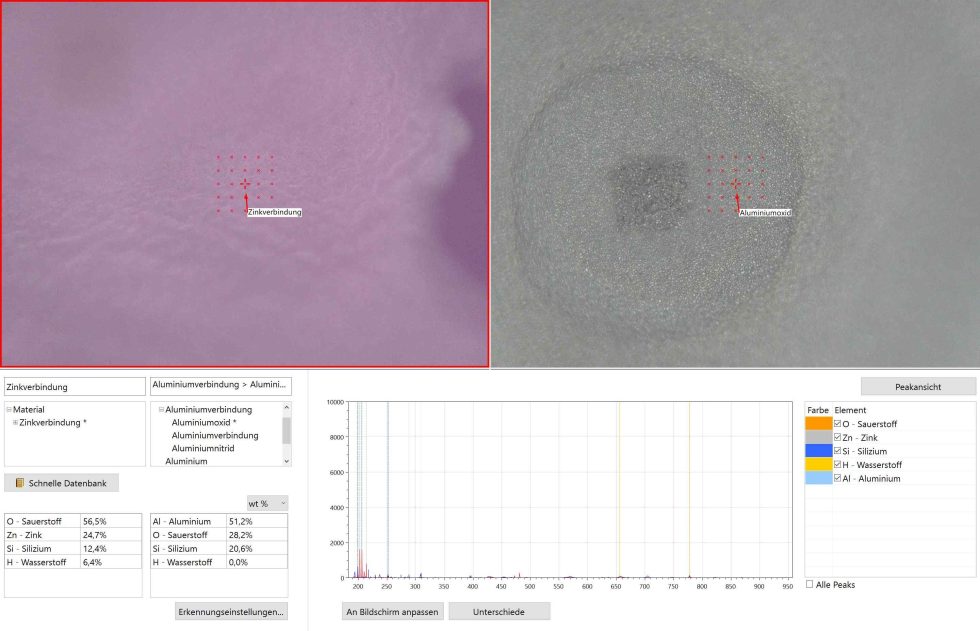Thermal paste comparison with laser-induced plasma spectroscopy: We discover a violet surprise!
Preliminary test: bleeding
It’s fascinating how well such a trivial test works over and over again. And no, this is intentionally not absorbent kitchen paper, but a normal white 80 g sheet from the copier. You can already see after 10 to 15 minutes that both the MasterGel Maker V2 and the CryoFuze are bleeding a lot. With the Apex, everything is in the green zone, even after two days. Everyone can make such a test for themselves and I personally would not use a paste that exhibits such behavior. And just as an aside: pure silicone would not migrate into the paper as widely as this. Another reason why the tension rises and rises….
Thermally conductive particles as a base and the fillers together with the binder
Each paste relies on certain particles of a chemical compound with the lowest possible thermal resistance. There are many possibilities here, up to and including diamond powder. However, there are also particles whose grain size plays a very important role for the subsequent performance. On the one hand, there is the shape, which can be platelet-shaped, crystal-shaped or rather round. On the other hand, of course, the particle size also plays a very important role. And this is where theory and practice already clash. Coarser grain sizes offer, at least on paper, lower thermal resistance, but also leave larger gaps between the particles and even the surface. This, in turn, also negatively affects the actual thermal conductivity of the entire compound. Higher grit sizes, however, normally also make the layers somewhat too thick. Too fine grit sizes, on the other hand, result in thinner layers under high pressure, but with a bit of bad luck make pastes too solid. Liquid, more slurry-like or a bit more viscous? With the grit size, you can control the consistency quite well in advance. It is clever to mix different grit sizes, i.e. something between 1 and 2 µm and something larger up to approx. 5 µm. Then you have something from both worlds.
And how do you get the gaps, e.g. between a corundum, filled appropriately? For everything below 1 µm, one uses a filler that is still as good a thermal conductor as possible and is much cheaper, often in the form of platelets. Especially the very fine grains of corundum, diamond and boron nitride are really expensive. The stuff has to be ground in a complex process, and that costs money. That’s why many cut at around 1 to 1.5 µm and fill up with additives. The cheapest are things like zinc oxide, which is also used as a base for cheaper pastes.
To ensure that the paste does not reach the customer as dust, various binders are used, which on the one hand also guarantee the final consistency of the paste and on the other hand represent one of the most important secrets when it comes to long-term durability (“reliability”) and performance in certain temperature windows. The pastes tested today can also be used for the sub-zero range, which of course poses different challenges for the binder than for a “normal” consumer paste. The silicone oils (linear polysiloxanes) that are almost always used are, from a purely chemical point of view, a middle ground between inorganic and organic chemistry. They have an inorganic framework (as in rocks and minerals) and contain certain organic residues. This positions them between silicates and plastics. The resulting properties are versatile and, above all, easily controllable.
Very important for the quality and shelf life of a paste as well as the congruent consistency of all batches is “conching”, i.e. the permanent and complete mixing of all components until the ideal distribution of all components is approximately achieved and maintained. The mass distribution will certainly never be perfect, but almost. But you know this from cocoa: if you don’t stir and shake constantly, the suspended solids sink to the bottom again over time and the paste dissolves. The only thing that helps is constant stirring and shaking.
Cooler Master MasterGel Maker V2 vs. Alphacool Apex
Let’s take a look at the older Cooler Master paste in the form of the MasterGel Maker V2 and compare it to the Alphacool Apex. The Master Gel is exactly what I described above. The large and more round grains in the spectra are extra-hard corundum in two grit sizes, a fairly common mineral in the oxides and hydroxides mineral class. It crystallizes in the trigonal crystal system with the chemical composition Al₂O₃ and thus, chemically speaking, is actually nothing other than aluminum oxide. Let’s move on to the more favorable filler, which we naturally also want to determine. And it is – what a coincidence – the favorable zinc oxide ZnO! But Cooler Master’s OEM should be able to explain where the 3.6% hydrogen is supposed to come from. And then there was the puddle around the blob in the form of leaking silicone.
The Apex has a completely different composition, because it uses corundum in considerably more than two grit sizes and some silicone oil as a binder. This means that you can do without the zinc oxide flakes as an inexpensive filler. It’s the simple that’s so hard to do, because handling such a “slurry” is not easy and only very good original manufacturers (not fillers) get a decent bond there at all. The MasterGel Maker V2, on the other hand, is a completely average Al₂O₃ (corundum) based thermal paste with a grain size between 1.5 and 5 µm and quite ordinary, finely ground zinc oxide as a filler. Only the water thing is very strange, but I will explain that later. However, I consider the stated 8 W/mK to be somewhat realistic. The Apex, on the other hand, is real high-tech and should also be very constant over time. The thermal conductivity of the Apex also seems quite optimistic, but it could well be over 10 W/mK. I will certainly measure that once in due course.
Cooler Master CryoFuze Violet vs. Alphacool Apex
The main thing is colorful? Well… We just had the Apex, so let’s concentrate on the colorful paste. And there I get big worry lines. What has been so lovingly colored is nothing more than cheap, pure zinc oxide with silicone. In other words, an extremely simple paste that could be located in the range around realistic 4 to 6 W/mK, but never in a lifetime above 10. That is hardly possible with pure ZnO. And yes also the over 6 percent hydrogen is plenty strange. So I would really think twice about using such a paste.
Summary and conclusion
It’s amazing how you can achieve such good results with so little time. That was enough to expose the CryoFuze from Cooler Master as a cheat pack, while the MasterGel Maker V2 proved to be a reasonably solid product. However, the fact that both samples contained huge amounts of hydrogen is probably evidence of rather careless work on the part of the filler. Especially the CryoFuze has the charm of a nice watercolour from my son’s paint box, because any corundum is missing (although it should have been there). The hydrogen content is also extremely high.
Of course, I sent Cooler Master the results in detail in advance and also a technical explanation. It is very positive that there was an official statement immediately and I will of course report further.
Aniek Stavast, Marketing Manager Thermal, Cooler Master
LIBS is a very helpful method, where you end up with results in a very short time, which you have to produce by SEM and EDX with much more effort. Sure, even LIBS has its drawbacks (nitrogen and its compounds are not reasonably detectable without an Argon box because they are present in ambient air), but the advantages outweigh them. Combined with the powerful microscope, this is a technical tour de force. And I am sure that I will gladly repeat such experiments again. After all, curiosity dies last.




































105 Antworten
Kommentar
Lade neue Kommentare
Urgestein
Mitglied
Urgestein
Mitglied
1
Urgestein
Urgestein
Veteran
Urgestein
1
Urgestein
1
Veteran
Urgestein
Mitglied
Urgestein
Veteran
1
Urgestein
Alle Kommentare lesen unter igor´sLAB Community →